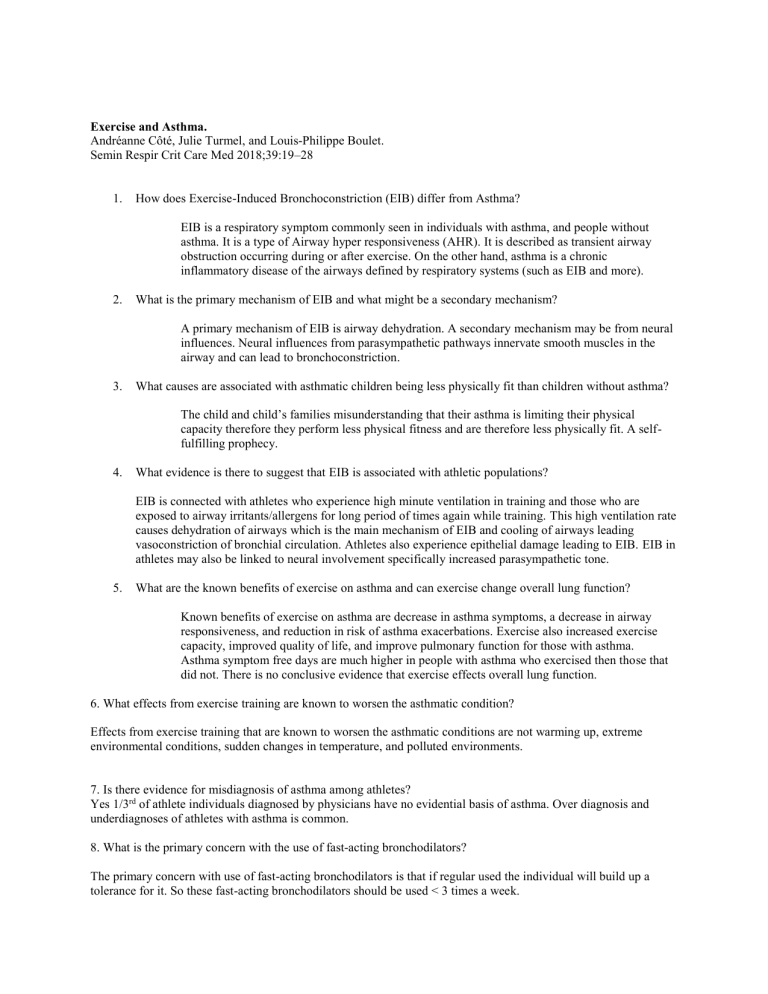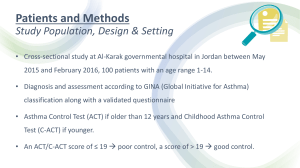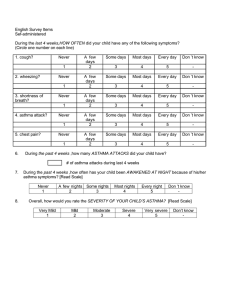
Exercise and Asthma. Andréanne Côté, Julie Turmel, and Louis-Philippe Boulet. Semin Respir Crit Care Med 2018;39:19–28 1. How does Exercise-Induced Bronchoconstriction (EIB) differ from Asthma? EIB is a respiratory symptom commonly seen in individuals with asthma, and people without asthma. It is a type of Airway hyper responsiveness (AHR). It is described as transient airway obstruction occurring during or after exercise. On the other hand, asthma is a chronic inflammatory disease of the airways defined by respiratory systems (such as EIB and more). 2. What is the primary mechanism of EIB and what might be a secondary mechanism? A primary mechanism of EIB is airway dehydration. A secondary mechanism may be from neural influences. Neural influences from parasympathetic pathways innervate smooth muscles in the airway and can lead to bronchoconstriction. 3. What causes are associated with asthmatic children being less physically fit than children without asthma? The child and child’s families misunderstanding that their asthma is limiting their physical capacity therefore they perform less physical fitness and are therefore less physically fit. A selffulfilling prophecy. 4. What evidence is there to suggest that EIB is associated with athletic populations? EIB is connected with athletes who experience high minute ventilation in training and those who are exposed to airway irritants/allergens for long period of times again while training. This high ventilation rate causes dehydration of airways which is the main mechanism of EIB and cooling of airways leading vasoconstriction of bronchial circulation. Athletes also experience epithelial damage leading to EIB. EIB in athletes may also be linked to neural involvement specifically increased parasympathetic tone. 5. What are the known benefits of exercise on asthma and can exercise change overall lung function? Known benefits of exercise on asthma are decrease in asthma symptoms, a decrease in airway responsiveness, and reduction in risk of asthma exacerbations. Exercise also increased exercise capacity, improved quality of life, and improve pulmonary function for those with asthma. Asthma symptom free days are much higher in people with asthma who exercised then those that did not. There is no conclusive evidence that exercise effects overall lung function. 6. What effects from exercise training are known to worsen the asthmatic condition? Effects from exercise training that are known to worsen the asthmatic conditions are not warming up, extreme environmental conditions, sudden changes in temperature, and polluted environments. 7. Is there evidence for misdiagnosis of asthma among athletes? Yes 1/3rd of athlete individuals diagnosed by physicians have no evidential basis of asthma. Over diagnosis and underdiagnoses of athletes with asthma is common. 8. What is the primary concern with the use of fast-acting bronchodilators? The primary concern with use of fast-acting bronchodilators is that if regular used the individual will build up a tolerance for it. So these fast-acting bronchodilators should be used < 3 times a week. 9. What non-pharmacological approach may be taken to reduce EIB occurrences by as much as 10%? High intensity, low, or variable intensity intervals continuous warm-ups results in attenuation of EIB by around 10% comparatively with no warmup. The same for high intensity interval warm ups as well. High intensity interval warm ups seem to be the most effective. 10. Which athletes might be most susceptible to have a diagnosis of Asthma or EIB? Endurance athletes are the most susceptive to having a diagnosis of Asthma or EIB. In particular swimmers and cross country skiers have an increased chance of getting diagnosed with AHR, asthma, and EIB. Outside of the paper: What are the primary differences between asthma and COPD? Both asthma and COPD are lung diseases that make it difficult to breath air but asthma is often triggered by allergens, mold, or physical activity. On the other hand, COPD is caused by emphysema and chronic bronchitis. What population is more likely effected by COPD? The population that smoke or breath in air filled with pollution and or chemicals for extended years are more highly effected by COPD.



